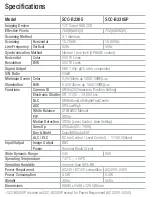
EL-2650XL
Distance of Detector
from Wall
(D)
5cm 25cm 50cm
Distance of Door/Window
from Detector
(W)
Up
to
2m*
+2 0 -1
4m
+2 0 -1
6m
+2 0 0
8m
+2 +1 0
9m
+2 +1 0
Table 1: Recommended PCB
Adjustment Scale Settings for Wall
and Ceiling Mounting
* It is not recommended to mount the unit less
than 40cm away from the path of entry
protected by the detector.
The EL-2650XL is a wireless PIR sensor that is able to distinguish between permitted and non-permitted motion. This allows the occupants free movement
within the premises while detecting intrusion via doors or windows. The sensor implements a feature to combat the problem of multiple transmissions, which
drastically reduce the life of the batteries. After a transmission is made, the EL-2650XL initiates a delay of approximately three minutes during which
transmissions will not be sent. The sensor operates in two selectable modes: Curtain and Directional.
Location of Detector
Consider the following before mounting the sensor:
•
Select a location from which the pattern of the sensor is most likely to be crossed by a
burglar, should there be a break in.
•
Avoid a location that comes in direct contact with radiators, heating/cooling ducts or air
conditioners.
•
Do not place bulky objects in front of the sensor.
Caution: Do not install the sensor above beds, sofas, desks or in any area that people
are likely to spend continued periods of time. If the occupant does not move within the
delay time, an alarm will be generated when moving away from the protected area.
Installation Instructions
1. To open the housing, remove the cover screw and, using a flathead screwdriver, press the
locking tab at the side of the unit. Remove the printed circuit board (PCB) by unscrewing the
PCB screw.
Note: Do not touch the face of the PYRO sensor.
2. Set the receiver to Registration mode. Apply battery power by removing the isolator that
separates the battery from the contacts on the battery holder. The sensor turns on and
sends four transmissions in order to be registered with the system. Wait for the receiver to
indicate that the transmitter has been registered successfully. Alternatively, the EL-2650XL
can be registered to the receiver by manually entering the transmitter's serial number.
Note: The receiver allocates a transmitter number to each registered unit. Write this
number and the number of the zone on the sticker provided. Affix the sticker inside the
front cover for future reference.
3. After a warm-up period of 130 sec. indicated by both LEDs' blinking, the sensor automatically
enters Radio Mode for 4 minutes approximately and sends transmissions every 8 seconds,
then it enters Regular mode
– see Operation and Adjustment, Selectable Operation Modes
.
4. Knock out the mounting holes and test the transmitter from the exact mounting position
before permanently mounting the unit. The EL-2650XL can be wall or ceiling mounted.
Note: The "Alarm" arrow on the PCB (See figures 1 and 2) must point inward (i. e.
towards the protected area).
The recommended height is 2.2 m.
Note: If you choose
mounting height other than recommended (which is not advised), please perform a
walk test to check the lens coverage. The recommended mounting height is the best in
terms of detection area
.
5. Attach the base to the wall with two screws. If using the rear tamper switch, insert a screw
into the rear tamper hole (
see Figure 6)
instead of the lower mounting hole. When the
detector is removed from the wall, the screw causes the tamper release to break away from
the back cover and the rear tamper switch is released.
6. Mount the PCB at the required setting using the horizontal adjustment scale and tighten the
PCB screw –
see Operation and Adjustment, PCB Adjustment
. Attach the front cover and
replace the cover screw.
Operation and Adjustment
PCB Adjustment
PCB adjustment enables you to angle the infrared beams by changing the position of the pyro element in relation to the lens. To adjust the PCB, loosen the
PCB screw and slide the PCB to the required position using the PCB adjustment scale as a guide. After adjusting the board, tighten the PCB screw. Slide the
board towards -2 to position the beams closer to the wall. Slide the board t2 to position the beams further away from the wall. For the correct PCB
adjustment, you must take into account the distance of the detector from the wall and the distance of the protected door/window from the detector –
see
Table 1 (below)
. The settings in Table 1 as illustrated in Figure 3 are relevant both to wall and ceiling mounting.
Figure 3
: A typical installation where the detector is 5cm from the wall and 2m from the protected window. The top two
diagrams show the lens coverage pattern for the detector when incorrectly adjusted to -2 and 0. The bottom diagram shows
the PCB correctly adjusted to +2.
Figure 1: EL-2650XL (Cover Off)
Figure 2: Correct Placement of the Detector
LED
Indicator
PCB
Screw
Tamper
Switch
Pyro
Sensor
Mode
Jumper
Alarm
Delay
Jumper
Battery
Holder
LED
Jumper
PCB
Adjustment
Scale



















